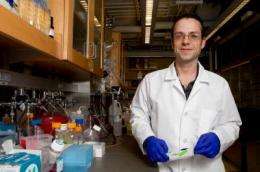Chemists influence stem-cell development with geometry (w/ Video)

University of Chicago scientists have successfully used geometrically patterned surfaces to influence the development of stem cells. The new approach is a departure from that of many stem-cell biologists, who focus instead on uncovering the role of proteins in controlling the fate of stem cells.
"The cells are seeing the same soluble proteins. In both cases it's the shape alone that's dictating whether they turn into fat or bone, and that hasn't been appreciated before," said Milan Mrksich, Professor in Chemistry and a Howard Hughes Medical Institute Investigator, who led the study. "That's exciting because stem-cell therapies are of enormous interest right now, and a significant effort is ongoing to identify the laboratory conditions that can take a stem cell and push it into a specific lineage."
The UChicago team found that making cells assume a star shape promotes a tense cytoskeleton, which provides structural support for cells, while a flower shape promotes a looser cytoskeleton. "On a flower shape you get the majority of cells turning to fat, and on a star shape you've got the majority of cells turning into bone," said Kris Kilian, a National Institutes of Health Fellow in Mrksich's research group. The UChicago team published its findings in the March 1 Early Edition of the Proceedings of the National Academy of Sciences.
Mrksich cautioned that the method is far from ready for use in the harvest of stem cells for therapeutic use, but it does signal a potentially promising direction for further study.
Mrksich's research group has a long history of developing methods for patterning surfaces with chemistry to control the positions, sizes and shapes of cells in culture, and applying those patterned cells to drug-discovery assays, and studies of cell migration and cell adhesion.
More information: "Geometric cues for directing the differentiation of mesenchymal stem cells," Proceedings of the National Academy of Sciences, March 1 Early Edition, by Kristopher A. Kilian, Branimir Bugarija, Bruce T. Lahn and Milan Mrksich.
Provided by University of Chicago














